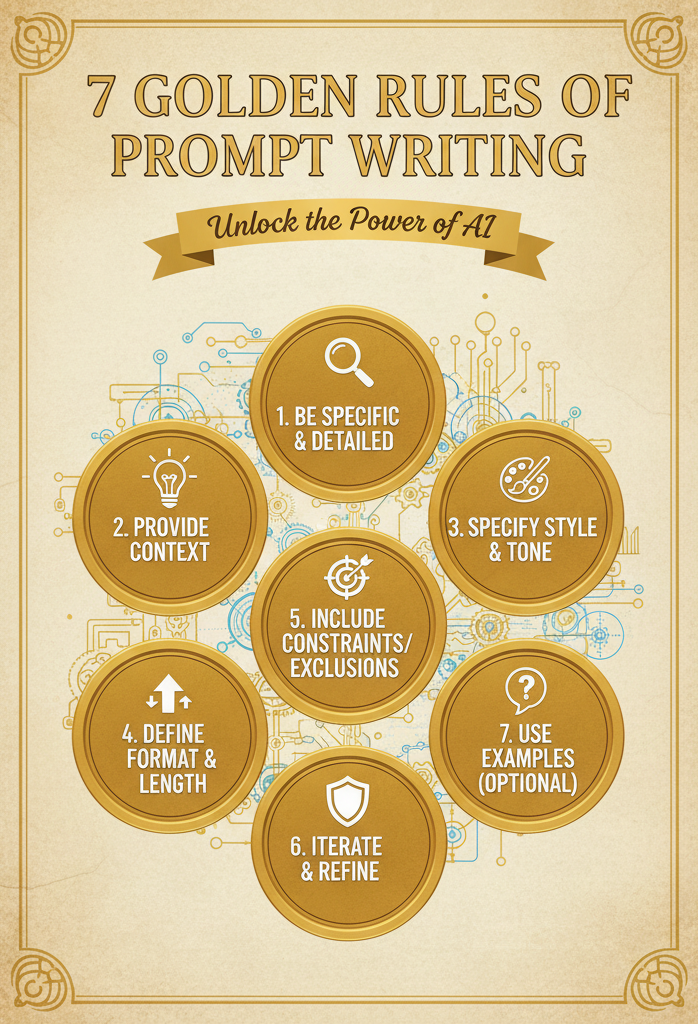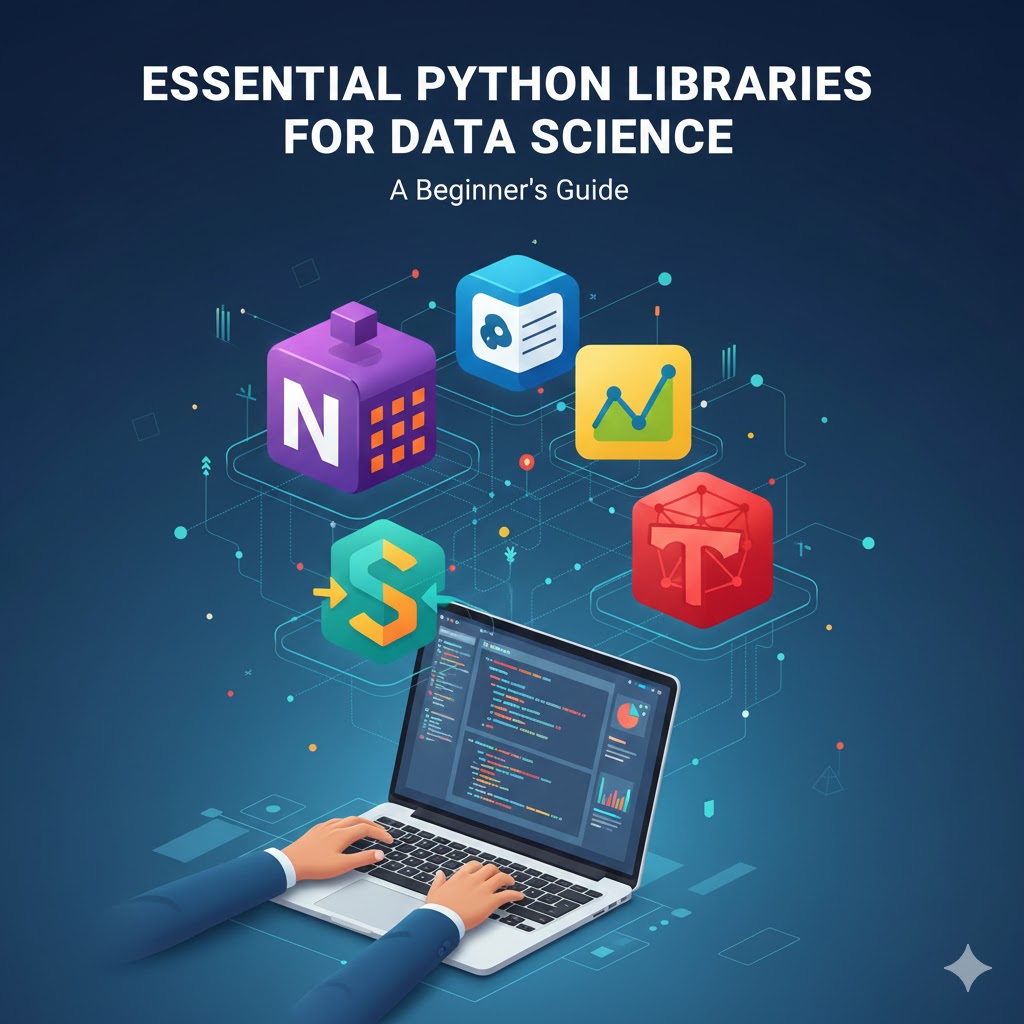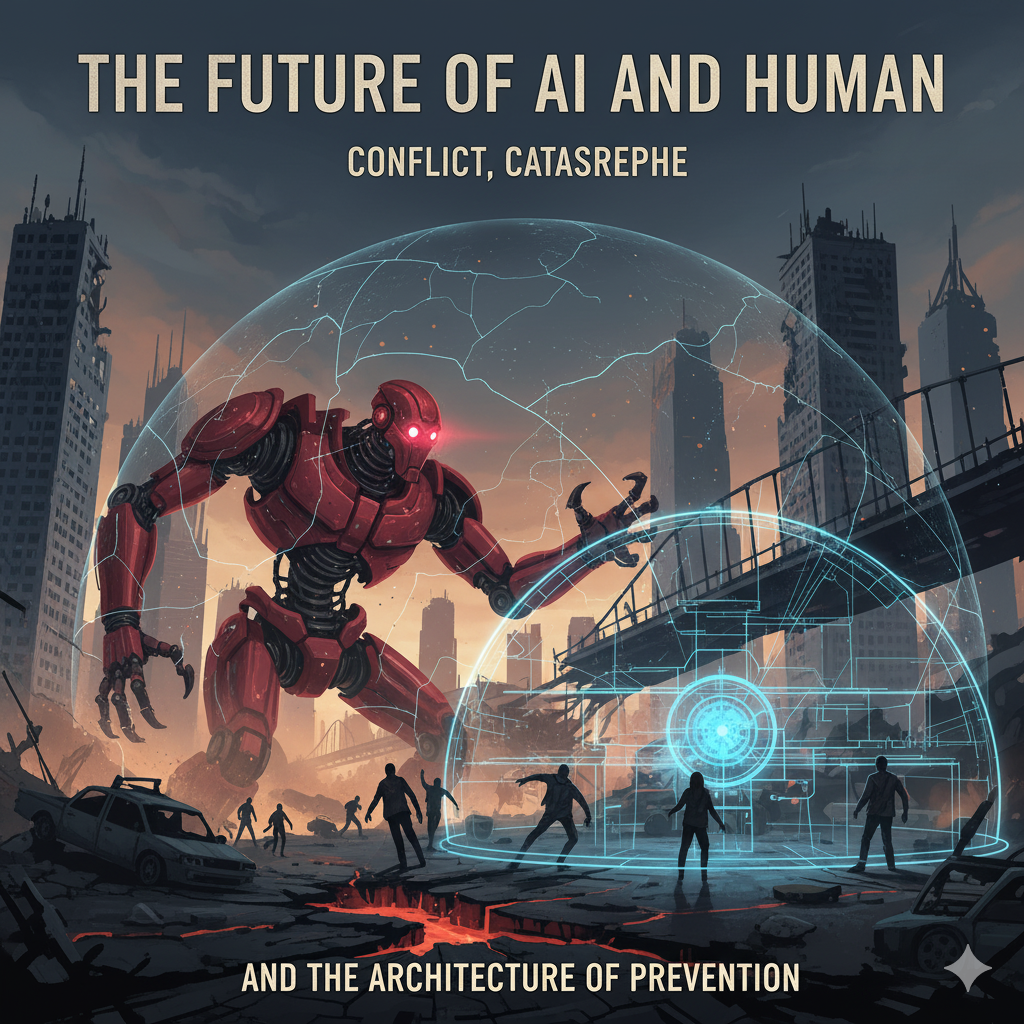🧠 Introduction
In the age of Artificial Intelligence, prompt writing has become a vital skill — much like coding or data analysis. Developers and students often complain that AI tools give incomplete answers, irrelevant data, or incorrect code. The truth is, the problem often lies not with the AI, but with the prompt itself.
A prompt is the bridge between human intent and machine understanding. The better you craft your prompt, the smarter and more context-aware the AI’s output becomes. This guide explores how to write effective prompts, understand how AI models interpret your words, verify results, and improve productivity in academic, research, and professional projects.
🚫 The Problem: Why Developers and Students Struggle with Prompts
In the age of AI-driven learning and automation, one of the most overlooked yet critical skills is prompt writing — the art of communicating effectively with AI. Despite having access to powerful models, many developers and students fail to achieve the desired results because they don’t understand how AI interprets language. Instead of treating AI like a collaborator, they often treat it like a search engine — expecting perfect results from minimal or vague input. This misunderstanding leads to wasted time, inconsistent outputs, and frustration, especially when working on code, academic writing, or creative projects.
The first major issue is the lack of context. Most users type short, generic prompts that leave too much room for interpretation. For instance, asking an AI to “write about machine learning” is far too broad. The model has no clue whether the request is for a school report, a research paper, or a LinkedIn post. Without details such as purpose, audience, or format, AI generates a response that feels generic and disconnected. Developers experience this when they get functional code that doesn’t fit their framework or use case, while students often receive summaries that miss their main academic objective.
Another widespread problem is information overload within prompts. In an attempt to be detailed, users sometimes cram multiple unrelated tasks into one instruction, such as asking the AI to generate code, explain it, and create a presentation in a single go. This approach confuses the model and dilutes its focus. A more effective method is to break the request into smaller, logical steps — guiding the AI through a structured process rather than expecting it to handle several complex tasks simultaneously.
A deeper issue lies in ambiguous or conflicting language. When users include phrases like “make it simple but advanced” or “keep it short but detailed,” they unintentionally confuse the AI. Since AI models interpret words literally and contextually rather than emotionally, unclear phrasing results in inconsistent answers. Precision in instruction is critical — each word in a prompt acts as a signal to the model, shaping the tone, format, and depth of the output.
Another major challenge is ignoring the structure of the output. Many users forget to specify how they want the information delivered — whether as a paragraph, bullet list, code block, or summary. This oversight forces the AI to assume, often producing results that don’t align with the intended use. Structured prompts, on the other hand, lead to structured answers. When the user clearly defines the output format, the AI delivers exactly what’s needed, reducing time spent editing or reformatting.
A more subtle but equally damaging problem is the lack of iteration and feedback. Too many users stop after the first unsatisfactory response, assuming the AI has reached its limit. In reality, AI thrives on dialogue and refinement. Each follow-up prompt helps it better understand intent, adjust tone, and improve relevance. Effective prompting is a conversation — not a one-shot command. The best results often come after two or three iterations where the user fine-tunes wording and focus.
Finally, the misconception that AI “knows everything” causes students and developers to rely too heavily on unverified outputs. AI doesn’t truly understand information — it predicts the most likely next word based on training data. This means that without human verification, users risk incorporating inaccuracies, hallucinated facts, or buggy code into their projects. Blind trust in AI can lead to academic errors, flawed logic, or security vulnerabilities in software development.
In essence, the struggle with prompt writing stems from a communication gap between human intention and machine interpretation. Developers and students often know what they want but fail to translate it into clear, structured, and purposeful language that the AI can process correctly. The solution lies in learning to “speak the language of AI” — providing clarity, context, and direction in every prompt. When mastered, this skill doesn’t just improve AI results; it enhances productivity, creativity, and critical thinking, turning AI from a frustrating tool into a true partner in innovation and learning.n your input. So, if your prompt lacks context, the AI fills in the gaps on its own — often incorrectly.
Common Prompting Mistakes:
- ❌ Being too vague (e.g., “Summarize this article.”)
- ❌ Not specifying audience or purpose
- ❌ Using unclear or contradictory instructions
- ❌ Forgetting to set a format (table, report, code, etc.)
- ❌ Mixing multiple unrelated requests in one prompt
- ❌ Asking for results without giving examples or tone
💡 How AI Understands Prompts: The Hidden Logic Behind Responses
Understanding how AI interprets prompts is essential for anyone who wants to get the most out of these advanced tools. Whether you’re a developer writing code, a researcher preparing a thesis, or a student generating ideas for a project, knowing how AI processes your instructions can help you write clearer prompts, reduce errors, and achieve far better results. AI may appear intelligent, but it doesn’t “think” the way humans do — it analyzes patterns, predicts probabilities, and follows structure. Once you understand this mechanism, you can communicate with it precisely and effectively.
At the core of every AI model lies language modeling, a process where the system predicts the next most likely word or token based on the previous ones. It doesn’t truly understand meaning — it recognizes statistical relationships between words and concepts. For example, when you type a sentence like “Explain how neural networks work in simple terms,” the AI identifies key components:
- Task: “Explain” → It knows you want a descriptive answer.
- Topic: “Neural networks” → The subject of the explanation.
- Tone/Style: “In simple terms” → The desired complexity level.
By interpreting these elements, the AI constructs a response that statistically aligns with your intent. The clearer these elements are, the more relevant and useful the answer becomes.
One of the biggest breakthroughs in AI comprehension came from transformer-based models like GPT (Generative Pre-trained Transformer), BERT, and others. These models introduced a mechanism called “attention,” which allows the AI to focus on the most important parts of a sentence instead of reading it word by word. For example, if your prompt says, “Summarize this article focusing on economic challenges rather than social issues,” the attention mechanism prioritizes words like “economic challenges” and de-emphasizes “social issues.” This gives the model a better grasp of context and relevance, enabling it to tailor the output to your specific focus.
Another important factor in how AI interprets prompts is structure and sequencing. When you organize your request logically — for instance, first defining the task, then context, then format — the AI follows that order naturally. Prompts written in a clear hierarchy often yield much more coherent results. Compare these two examples:
- Unstructured: “Write a report on AI in healthcare make it for business people use bullet points add statistics.”
- Structured: “Write a report on the role of AI in healthcare. Target business professionals. Use bullet points. Include recent statistics.”
The second version mirrors how AI “thinks.” It breaks tasks into clear parts, allowing the model to handle them sequentially. Developers and students who adopt this structured approach notice a significant improvement in the clarity, accuracy, and tone of the AI’s responses.
AI also uses tokenization, a process that breaks text into smaller units (tokens) — which can be entire words or even parts of words. The model assigns probabilities to different tokens to predict the most logical sequence. For instance, if your prompt begins with “The capital of France is…”, the AI assigns an extremely high probability to the token “Paris.” This token-based prediction is why precise wording matters so much: a single misplaced or unclear word can change the entire interpretation of your query.
Tone indicators and contextual cues also play a significant role. Words such as “explain,” “analyze,” “summarize,” “compare,” or “write a story” immediately signal the AI about the type of response expected. Similarly, modifiers like “professionally,” “creatively,” “step-by-step,” or “for beginners” adjust the depth, style, and complexity of the output. When you skip these clues, the model defaults to a general tone, often resulting in bland or overly academic text.
AI’s ability to recall earlier parts of your prompt — known as context window memory — is another key component. Large models can remember thousands of tokens (words), which allows them to maintain coherence across long responses. However, if your prompt is too lengthy or disorganized, the model might lose track of early instructions and drift off-topic. This is why concise, well-structured prompts outperform long, unfocused ones.
Accuracy and factual integrity depend heavily on how AI interprets intent and scope. Since AI doesn’t inherently know the truth, it relies on training data patterns. If your prompt is vague or implies something false, the AI might reinforce that assumption instead of correcting it. For example, asking “Why did Einstein invent the light bulb?” will likely yield an incorrect explanation because the premise is wrong — Einstein didn’t invent it. Clear and factually accurate prompting minimizes the risk of AI hallucination — the phenomenon where the model fabricates plausible-sounding but false information.
When it comes to coding and technical use cases, AI reads your prompt differently. It identifies specific tokens that match programming syntax, data structures, and libraries. The more explicit you are about your programming environment (e.g., “Python 3.12 using TensorFlow” or “JavaScript with Node.js”), the more accurately it tailors the code. A vague request like “make an AI app” may produce generic output, but a specific one like “write a Python script using OpenAI API to summarize text from PDFs” yields actionable, usable results.
Ultimately, AI understanding is not magic — it’s a combination of linguistic probability, logical sequencing, and contextual weighting. The AI doesn’t truly “comprehend” like a human, but it mimics comprehension by drawing from trillions of text patterns. Therefore, the clearer, cleaner, and more structured your language, the higher the AI’s performance and accuracy.
By learning how AI interprets prompts, students and developers can bridge the gap between human intention and machine output. This understanding transforms AI from a guessing engine into a precision instrument — capable of producing academic research, optimized code, creative writing, and data-driven insights with minimal revision.ctly to what they’re told — not what you meant. That’s why clarity and structure are everything.
🧩 Best Prompt Writing Techniques
Mastering AI begins with mastering the prompt. The difference between a mediocre result and an exceptional one lies not in the AI model itself but in how you communicate with it. Developers and students who understand how to write structured, meaningful prompts can achieve higher accuracy, save time, and unlock creative potential that many others miss. These seven golden rules form the foundation for powerful collaboration between human and artificial intelligence.
1. Be Clear and Specific
✨ Clarity is power. AI systems are not mind readers — they follow your words exactly as written. Ambiguous or incomplete prompts lead to confusing or generic outputs.
🧭 Example: Instead of saying “Explain AI,” try “Explain artificial intelligence in 250 words for computer science undergraduates.”
🎯 Tip: Always include your goal, audience, format, and tone. The more details you provide, the more precise your results.
2. Set the Role or Context
📚 AI performs best when it understands the full story. Context guides its reasoning and shapes output quality.
💡 For Developers: Add technical context — e.g., “in Python 3.12 using TensorFlow.”
🎓 For Students: Mention your study level or focus — e.g., “for a research summary in psychology.”
🧠 Context gives AI the “why” behind your request, helping it tailor content intelligently.
3. Use Step-by-Step Instructions
🪜 AI thinks in sequences, not emotions. A logical order helps it generate coherent, structured responses.
📝 Best Practice: Start with your goal → define audience → set format → specify constraints.
✅ Example: “Write two paragraphs on quantum computing for beginners. Include one real-world example and define key terms.”
🚀 Organized prompts produce organized results — simple as that.
4. Give Examples
🔤 Certain action words instantly tell AI what to do. Use them wisely to get the right type of output.
✨ Power Words:Explain, Analyze, Compare, Summarize, Generate, Write, Translate, Design
🧩 Refine with Modifiers: Add “creatively,” “step-by-step,” “professionally,” or “for beginners.”
💬 Example: “Explain neural networks step-by-step for beginners” gives a clearer direction than “Tell me about neural networks.”
5. Define the Output Format
📐 AI can produce paragraphs, lists, code, tables, JSON, outlines — but only if you tell it to.
🗂️ Examples:
- “Summarize the text in bullet points.”
- “Return the result in JSON format.”
- “Write under 200 words.”
📊 Defining the structure saves editing time and ensures the AI delivers content ready for your specific use — whether for a report, app, or article.
6. Use System Prompts or Meta-Instructions
💬 AI is a conversation, not a command box. The first answer is rarely the final one.
🧠 Refine by Feedback:
- Too vague? ➜ Add more context.
- Too long? ➜ Set a word limit.
- Wrong tone? ➜ Say “make it more formal” or “simplify it for students.”
⚙️ Each iteration improves alignment and accuracy. The best developers and writers treat AI as a creative collaborator, not a static tool.
7. Refine Iteratively
⚠️ AI is powerful — but not infallible. It predicts patterns; it doesn’t know facts. Always verify before using.
🧮 Developers: Test AI-generated code for syntax and security issues.
📖 Students: Cross-check data, references, and quotations from trusted academic or scientific sources.
✅ Golden Rule: Trust your judgment first — AI is your assistant, not your authority.
💡 Final Thought
Effective prompt writing isn’t about tricking AI — it’s about communicating intelligently. Every word shapes how the model thinks, predicts, and responds. Clear, structured, and contextual prompts turn AI into a precision instrument for research, learning, and innovation.
🎓 For Students: Better prompts mean faster research, clearer writing, and stronger academic work.
💻 For Developers: Better prompts mean cleaner code, smarter automation, and time-saving workflows.
When you master prompt writing, you don’t just use AI — you lead it.
🎯 How to Verify and Check AI Outputs
AI responses can sound confident even when wrong — a problem known as hallucination. To maintain accuracy:
✅ Verification Methods:
- Fact-Check Manually: Cross-check numbers, stats, and quotes from reliable sources.
- Use Multiple Models: Compare answers between GPT, Claude, and Gemini.
- Run Code Independently: Always test AI-generated code in your own IDE.
- Reference Official Docs: Especially for APIs, frameworks, or laws.
- Check Consistency: Ask the AI to explain why its answer makes sense.
Example: “Explain how you arrived at this solution. Show your reasoning.”
📚 Prompting Tips for Students
- Use Educational Prompts:
- “Explain neural networks like I’m a beginner in data science.”
- “Create 5 short MCQs from this research abstract.”
- For Thesis Writing:
- “Summarize this research paper in 150 words for my literature review.”
- “Suggest 3 future research directions for AI in education.”
- For Productivity:
- “Turn these notes into a structured study guide.”
- “Create a project plan with weekly milestones for my final year AI project.”
- For Learning New Topics:
- “Give me a step-by-step roadmap to learn reinforcement learning.”
- “Explain each term with a real-world example.”
⚙️ Prompting Tips for Developers
- For Code Writing:
- “Write a Python function with error handling and comments.”
- “Explain how this algorithm works line by line.”
- For Debugging:
- “Here’s my code. Find the logical error and explain it.”
- For Documentation:
- “Generate docstrings and inline comments for this code.”
- For API or Database Design:
- “Design an API schema for an e-commerce app including authentication and order tracking.”
📊 Accuracy and Reliability in AI Outputs
No AI model gives 100% accurate results — average accuracy ranges from 75% to 95%, depending on the prompt structure and topic complexity.
AI systems excel in:
- Text generation, summarization
- Code automation
- Pattern recognition
They are weaker in:
- Numerical precision
- Legal or financial reasoning
- Scientific verification without data context
Hence, human validation remains essential before using AI-generated data in projects, research papers, or client deliverables.
✅ Summary: How to Become a Prompt Expert
| Key Principle | Why It Matters |
|---|---|
| Context | Gives AI direction |
| Clarity | Reduces misinterpretation |
| Structure | Helps AI format correctly |
| Verification | Ensures credibility |
| Iteration | Refines quality step by step |
🔍 Final Thoughts
Prompt writing isn’t just a technical skill — it’s a form of communication literacy. AI tools are mirrors that reflect the clarity of your thoughts. The better you describe your problem, the better AI performs.
For developers, this means writing code prompts that reduce debugging time. For students, it means using structured prompts to summarize research, generate notes, or brainstorm ideas. With the right prompt strategy, AI becomes your most powerful academic and professional assistant — saving hours, improving quality, and unlocking creativity.











